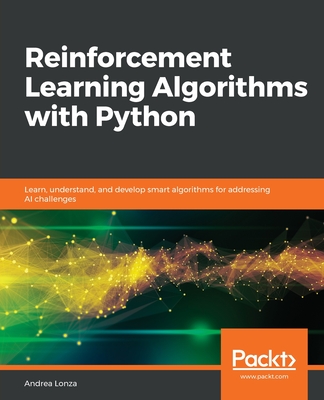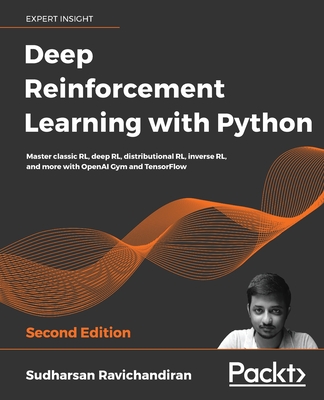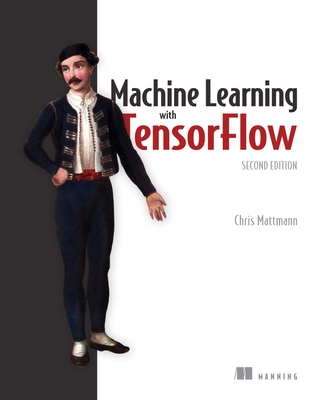Reinforcement Learning: An Introduction, 2/e (Hardcover)
暫譯: 強化學習:入門,第2版(精裝本)
Richard S. Sutton, Andrew G. Barto
- 出版商: A Bradford Book
- 出版日期: 2018-11-13
- 售價: $1,750
- 貴賓價: 9.8 折 $1,715
- 語言: 英文
- 頁數: 552
- 裝訂: Hardcover
- ISBN: 0262039249
- ISBN-13: 9780262039246
-
相關分類:
Reinforcement
-
相關翻譯:
強化學習, 2/e (Reinforcement Learning: An Introduction, 2/e) (簡中版)
Reinforcement Learning|強化學習深度解析 (繁體中文版) (Reinforcement Learning: An Introduction, 2/e) (繁中版)
銷售排行:
🥈 2018/11 英文書 銷售排行 第 2 名
立即出貨
買這商品的人也買了...
-
 Pattern Recognition and Machine Learning (Hardcover)
Pattern Recognition and Machine Learning (Hardcover)$4,300$4,085 -
 Pattern Recognition, 4/e (Hardcover)
Pattern Recognition, 4/e (Hardcover)$4,050$3,848 -
 $3,325The Elements of Statistical Learning: Data Mining, Inference, and Prediction, 2/e (Hardcover)
$3,325The Elements of Statistical Learning: Data Mining, Inference, and Prediction, 2/e (Hardcover) -
 Networks: An Introduction (Hardcover)
Networks: An Introduction (Hardcover)$1,780$1,744 -
 Introduction to Algorithms, 3/e (Hardcover)
Introduction to Algorithms, 3/e (Hardcover)$1,750$1,715 -
 Learning From Data (Hardcover)
Learning From Data (Hardcover)$1,200$1,176 -
 Programming in Scala : Updated for Scala 2.12, 3/e
Programming in Scala : Updated for Scala 2.12, 3/e$2,470$2,347 -
 Deep Learning (Hardcover)
Deep Learning (Hardcover)$1,650$1,617 -
 $948Scala for the Impatient,2/e
$948Scala for the Impatient,2/e -
 $796深度學習
$796深度學習 -
 演算法圖鑑:26種演算法 + 7種資料結構,人工智慧、數據分析、邏輯思考的原理和應用 step by step 全圖解
演算法圖鑑:26種演算法 + 7種資料結構,人工智慧、數據分析、邏輯思考的原理和應用 step by step 全圖解$450$356 -
 Beyond Bullet Points: Using PowerPoint to tell a compelling story that gets results, 4/e (Paperback)
Beyond Bullet Points: Using PowerPoint to tell a compelling story that gets results, 4/e (Paperback)$1,150$1,093 -
 $1,188Deep Reinforcement Learning Hands-On
$1,188Deep Reinforcement Learning Hands-On -
 $2,970Natural Language Processing with PyTorch
$2,970Natural Language Processing with PyTorch -
 Generative Adversarial Networks Projects: Build next-generation generative models using TensorFlow and Keras
Generative Adversarial Networks Projects: Build next-generation generative models using TensorFlow and Keras$1,850$1,758 -
 Exploratory Data Analysis (Classic Version)
Exploratory Data Analysis (Classic Version)$5,070$4,817 -
 用 Python 實作強化學習|使用 TensorFlow 與 OpenAI Gym (Hands-On Reinforcement Learning with Python)
用 Python 實作強化學習|使用 TensorFlow 與 OpenAI Gym (Hands-On Reinforcement Learning with Python)$520$411 -
 $756強化學習, 2/e (Reinforcement Learning: An Introduction, 2/e)
$756強化學習, 2/e (Reinforcement Learning: An Introduction, 2/e) -
 Business Data Science: Combining Machine Learning and Economics to Optimize, Automate, and Accelerate Business Decisions
Business Data Science: Combining Machine Learning and Economics to Optimize, Automate, and Accelerate Business Decisions$1,650$1,568 -
 動手做深度強化學習 (Deep Reinforcement Learning Hands-On)
動手做深度強化學習 (Deep Reinforcement Learning Hands-On)$690$538 -
 $2,432BPF Performance Tools : Linux System and Application Observability (Paperback)
$2,432BPF Performance Tools : Linux System and Application Observability (Paperback) -
 加密與解密:軟體保護技術攻防指南
加密與解密:軟體保護技術攻防指南$980$833 -
 $455代碼精進之路 : 從碼農到工匠
$455代碼精進之路 : 從碼農到工匠 -
 $1,788Deep Reinforcement Learning Hands-On, 2/e (Paperback)
$1,788Deep Reinforcement Learning Hands-On, 2/e (Paperback) -
 Reinforcement Learning|強化學習深度解析 (繁體中文版) (Reinforcement Learning: An Introduction, 2/e)
Reinforcement Learning|強化學習深度解析 (繁體中文版) (Reinforcement Learning: An Introduction, 2/e)$1,200$948
相關主題
商品描述
The significantly expanded and updated new edition of a widely used text on reinforcement learning, one of the most active research areas in artificial intelligence.
Reinforcement learning, one of the most active research areas in artificial intelligence, is a computational approach to learning whereby an agent tries to maximize the total amount of reward it receives while interacting with a complex, uncertain environment. In Reinforcement Learning, Richard Sutton and Andrew Barto provide a clear and simple account of the field's key ideas and algorithms. This second edition has been significantly expanded and updated, presenting new topics and updating coverage of other topics.
Like the first edition, this second edition focuses on core online learning algorithms, with the more mathematical material set off in shaded boxes. Part I covers as much of reinforcement learning as possible without going beyond the tabular case for which exact solutions can be found. Many algorithms presented in this part are new to the second edition, including UCB, Expected Sarsa, and Double Learning. Part II extends these ideas to function approximation, with new sections on such topics as artificial neural networks and the Fourier basis, and offers expanded treatment of off-policy learning and policy-gradient methods. Part III has new chapters on reinforcement learning's relationships to psychology and neuroscience, as well as an updated case-studies chapter including AlphaGo and AlphaGo Zero, Atari game playing, and IBM Watson's wagering strategy. The final chapter discusses the future societal impacts of reinforcement learning.
商品描述(中文翻譯)
這本廣泛使用的強化學習教材的新版本已大幅擴充和更新,強化學習是人工智慧中最活躍的研究領域之一。
強化學習是人工智慧中最活躍的研究領域之一,它是一種計算學習方法,透過代理在與複雜且不確定的環境互動時,試圖最大化所獲得的總獎勵。在《Reinforcement Learning》一書中,Richard Sutton 和 Andrew Barto 清晰且簡單地闡述了該領域的關鍵概念和演算法。這第二版已大幅擴充和更新,介紹了新主題並更新了其他主題的內容。
與第一版類似,這第二版專注於核心的在線學習演算法,數學材料則以陰影框的形式呈現。第一部分涵蓋了強化學習的盡可能多的內容,而不超出可以找到精確解的表格案例。這部分介紹的許多演算法在第二版中是新的,包括 UCB、期望 Sarsa 和雙重學習。第二部分將這些概念擴展到函數近似,新增了有關人工神經網絡和傅立葉基底等主題的章節,並擴展了對於離線學習和策略梯度方法的處理。第三部分新增了強化學習與心理學和神經科學之間關係的章節,以及更新的案例研究章節,包括 AlphaGo 和 AlphaGo Zero、Atari 遊戲以及 IBM Watson 的賭注策略。最後一章討論了強化學習對未來社會的影響。






























